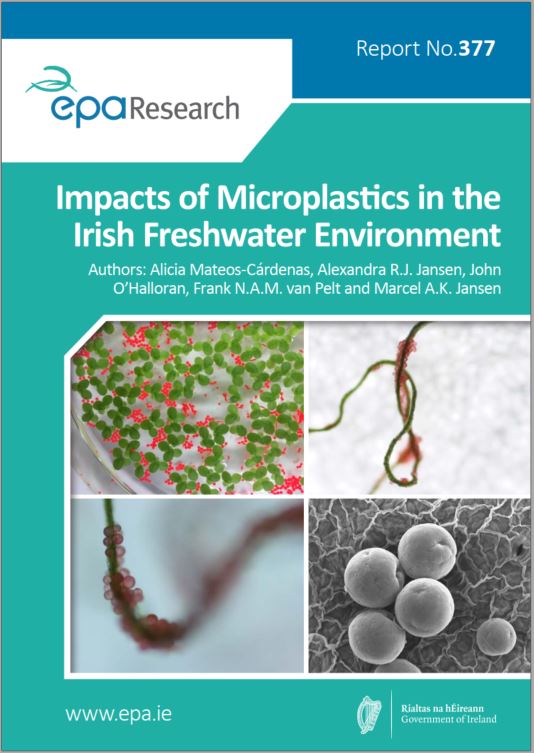Research 377: Impacts of Microplastics in the Irish Freshwater Environment
Authors: Alicia Mateos-Cárdenas, Alexandra R.J. Jansen, John O’Halloran, Frank N.A.M. van Pelt and Marcel A.K. Jansen
Summary: Plastics are a key part of modern life, due to their desirable characteristics such as light weight and low cost. However, the extensive production of plastics is resulting in plastic pollution. This study recognises the risk posed by rapid formation of micro- and nanoplastics in the freshwater environment and advocates the rapid development of field-monitoring and impact studies to analyse hazards and risks posed by these plastics.

Project Highlights
Watch the project highlights video
Identifying Pressures
Plastics are a key part of a modern lifestyle, because of their desirable characteristics such as durability, light weight, mouldability and low cost. However, the extensive production and application of plastics (> 440 million tonnes of plastics and plastic fibres per annum) is resulting in plastic pollution. Plastic waste is widespread in the natural environment, where it is associated with a range of negative impacts on organisms and ecosystems. Of special environmental concern are small plastic fragments, referred to as microplastics. Microplastics are ubiquitous in the freshwater environment, and comprise a complex mixture of diverse chemicals, sizes, shapes and charges. The biological impacts of these plastics in freshwater environments have not been widely studied. These plastics have been categorised as “contaminants of emerging concern”. A healthy freshwater environment is of critical ecological, economic, cultural and aesthetic importance for society. However, despite being widespread, little is known about the fate of microplastics in the freshwater environment and the impacts of these plastics on organisms, food chains and, ultimately, the human population.
Informing Policy
The Water Framework Directive emphasises the need to achieve “good quality” water status. However, relevant freshwater policy documents by and large fail to refer specifically to microplastics or nanoplastics. This is the result of inadequate information on the source, fate and impact of microplastics in the freshwater environment. Such knowledge is therefore urgently required to inform policy documents. The trophic transfer of microplastics into the food chain and the rapid fragmentation of microplastics into nanoplastics are of concern. To avoid these processes from happening, plastic pollution needs to be prevented and/or plastic pollutants need to be captured at the source. This study emphasises the importance of policies that limit the release of plastics in the freshwater environment and an approach that focuses on reducing, reusing and recycling plastics (e.g. Closing the Loop – An EU Action Plan for the Circular Economy, the European Green Deal and the Irish Waste Action Plan for a Circular Economy).
Developing Solutions
This study has generated accurate data on the biological impacts of key microplastics on two representative freshwater species common in Ireland: Lemna minor and Gammarus duebeni. It has been shown that freshwater systems do not simply transport plastics from land to the marine environment; they are microplastic pollution sinks. Three processes are highlighted to be of concern: (1) the trophic transfer of microplastics into the food chain, (2) the rapid fragmentation of microplastics into nanoplastics and (3) the ingestion of microfibres. To avoid these processes from happening, regulatory policies need to prioritise the prevention of plastic pollution and/or the capture of plastic pollutants at the source, taking into consideration the broad range of potential sources and their (often unknown) relative importance. This study has also highlighted the adsorption of microplastics to plant surfaces and this warrants further investigation to explore the development of solutions, including phytoremediation and/or phytomonitoring of microplastics and nanoplastics in the freshwater environment. Furthermore, this study strongly recognises the risk posed by rapid formation of nanoplastics in the freshwater environment, and advocates the rapid development of both field-monitoring and impact studies to analyse the hazards and risks posed by these nanoplastics.
https://www.epa.ie/media/epa-2020/research/epa-funded-research/Report-cover-377.jpg